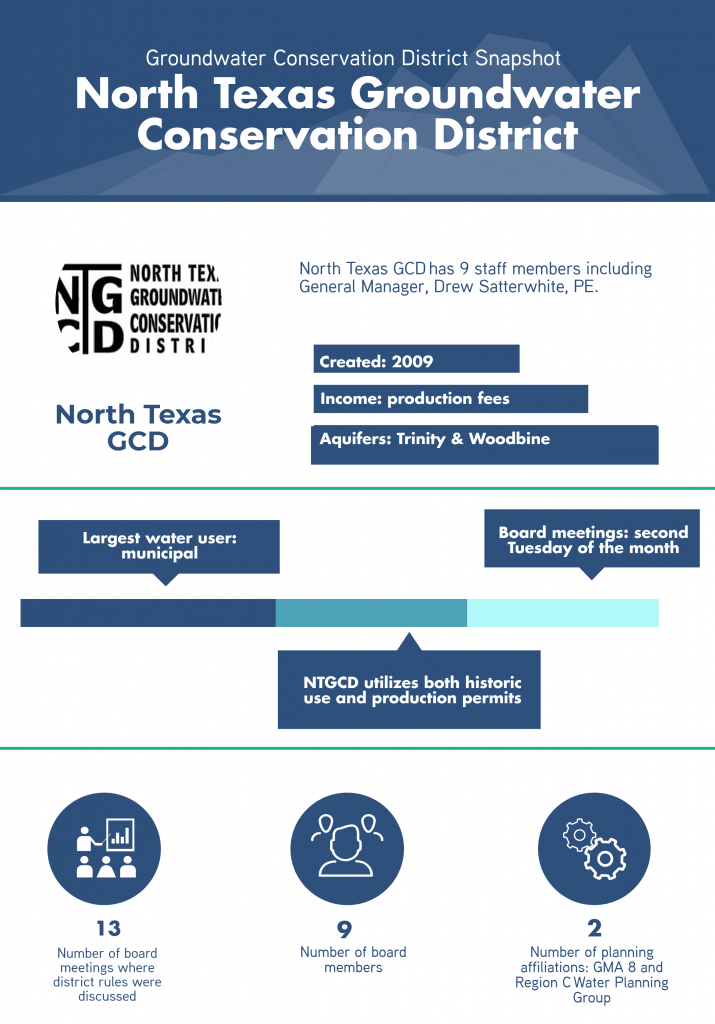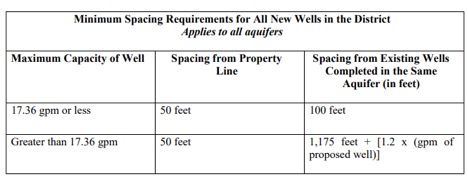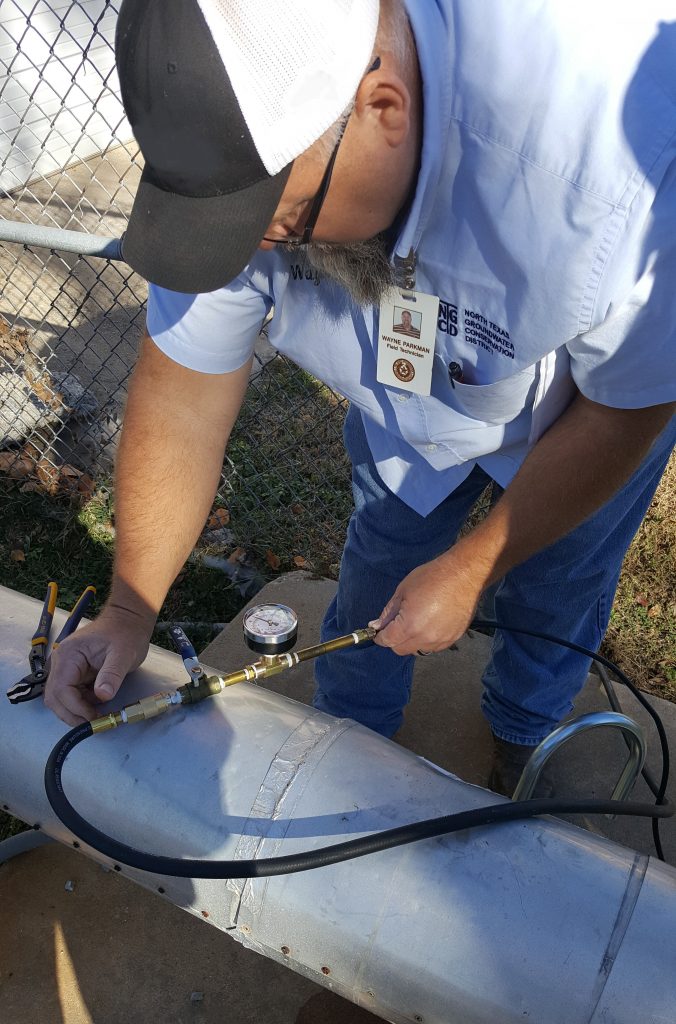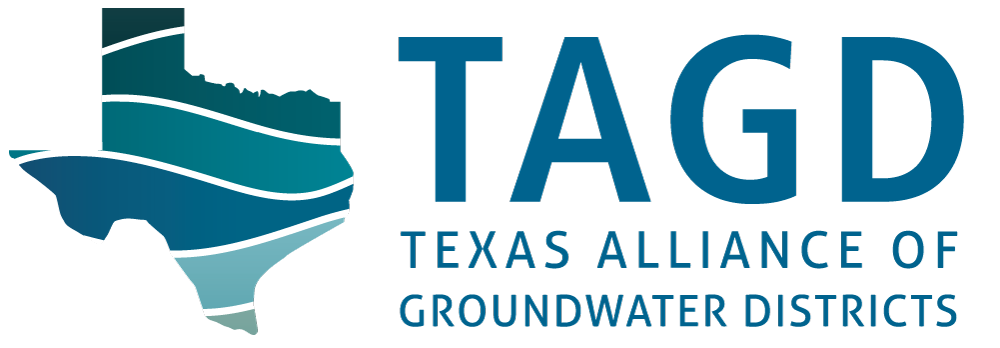North Texas GCD

Rules
North
Texas Groundwater Conservation District (NTGCD) adopted permanent rules in December of 2018. TAGD
sat down with NTGCD to learn more about the rule adoption process, and is
sharing some of the takeaways with you here.
TAGD: Can you describe
the process your district went through in developing rules?
NTGCD:
Our rules were developed over the course of 13 public board meetings. As a result, the Board committed a lot of
their time to the process of rulemaking–the District relied on the full Board,
not just select committees, to develop the rules. Each major change in the
rules was thoroughly deliberated by the Board over the course of these public
meetings. The District’s legal counsel Kristen Fancher, with Fancher Legal, and
our consulting hydrogeologist James Beach, with WSP, were also very involved in
helping the District promulgate rules.
TAGD: Did you hold
any stakeholder meetings as a part of the rule development process?
NTGD: As I mentioned earlier, the rules
were dissected piece-by-piece at our regular Board meetings, instead of at the committee
level, so as to give ample opportunity for interested parties to participate in
the process. The District follows the statutory requirements on agenda
postings, but in addition, we also send out emails containing Board Agendas and
Packets to all well owners, drillers, and other interested parties prior to
every meeting. Interested parties attending meetings were encouraged to
participate in the rule discussion.
While
NTGCD did not hold any specific stakeholder meetings, there were several staff-level
meetings with stakeholders–drillers, producers, and pump suppliers–where rule
development was discussed. These meetings proved very beneficial to the
District as we were able to take different perspectives into account prior to
adopting the rules.
TAGD: Any
surprises along the way?
NTGCD:
Not really. We did receive comments from
the drilling community on the exempt well threshold and how the drillers would
be able to drill an exempt well and ensure that it met the new 17.36 gpm exemption
threshold. The District flow tests
completed wells and the concern was that it is difficult to size a pump for an
exact flow rate given the variance of aquifer conditions and properties at any
given location. In response to this
concern, the District utilized pump curves provided by the local pump suppliers
to better understand the flow variance for pumps and worked with local drillers
to develop a flow testing procedural document which allows for a reasonable
margin of error.
TAGD: As you were
designing your rules, what were your primary objectives?
NTGCD:
We were really just trying to make sure that every major component of the rules
received healthy consideration, and that we carefully reviewed each change and
its impact to the regulated community.
With the Board being such active participants in the development, we
were able to discuss and debate with many different perspectives.
TAGD: What
projects/scientific studies were undertaken to inform the district’s rules?
NTGCD:
Several Districts in GMA 8 undertook a $1.9 million project to update the
State’s Northern Trinity /Woodbine Groundwater Availability Model prior to the
last round of joint planning. Not only
did this project help for Joint Planning purposes, but NTGCD also used the
updated model to inform decisions made in regard to well spacing rules. Utilizing the new model, James Beach’s team
provided a substantial amount of spacing analysis. While this was obviously discussed a lot
amongst staff and the consulting teams outside of Board Meetings, the spacing
analyses and options were presented, discussed and debated in at least 6 Board
Meetings. Each presentation and
discussion included a detailed review of the data supporting the spacing rules.
Permitting
TAGD: Please
describe the permitting approach that you adopted in your rules.
NTGCD: The District utilizes both Historic Use Permits and
Production Permits based on reasonable demand.
This approach was selected based on local development, land use and
aquifer conditions within the District. Both
the new spacing and permitting rules were developed in consideration of the
historical development and the expected growth and increase in demand in the
District. The regional and state water
planning process has identified surface water supplies to meet much of the
expected increase in demand over the planning cycle, and the District carefully
evaluated these projections throughout the last round of joint planning and in
its rules development.
More on NTGCD Permitting
- Historic
Use Permits: Non-Exempt well owners that were registered with the District
prior to the adoption of permanent rules receive a Historic Use permit based
upon their metered usage from 2010-2018 (the Historic Use Period), with certain
limited alternatives available to recognize historic use. - Production
Permits: Any additional water that users may need or any water a new well
owner may need must be applied for by justifying reasonable demand. - Drought
Buffer: The District Board of Directors also chose to incorporate a drought
buffer into permits that is triggered during extreme drought in order to lessen
the impact to permittees during such drought conditions. - Spacing
Requirements: New wells or wells that propose to increase production
capacity are required to follow the Districts spacing requirements which are detailed
in the chart below.

- Hydrogeological
Report: In addition, new wells or well systems capable of producing 200 gpm
or more are required to submit a Hydrogeological Report which provides the
District with more detailed information on how a proposed well would impact the
DFC as well as existing wells in the vicinity of the proposed well.
District Programs & Operations

TAGD:
Tell us a little about your monitoring well program.
NTGCD:
The District has a monitoring well program composed of monitor wells that were
inherited from the Texas Water Development Board. NTGCD is in the process of
trying to broaden the coverage by adding additional wells. The District currently uses e-tape, steel
tapes and an air compressor for water level monitoring. We hope to add several continuous monitoring
level devices–pressure transducers and acoustic–in the near future.
TAGD:
Sounds like a helpful set of data to have around. How does the district access
this information and other data?
NTGCD:
The District is currently under contract with INTERA to develop a new and
comprehensive database. Some of the goals of this project are to improve the
ways in which the District is able to consume data, improve on operational
efficiency, improve the application process for drillers and well owners, and
develop a more convenient and error-resistant method for users to submit meter
readings to NTGCD.
Helpful Resources
Visit NTGCD’s website at northtexasgcd.org.
